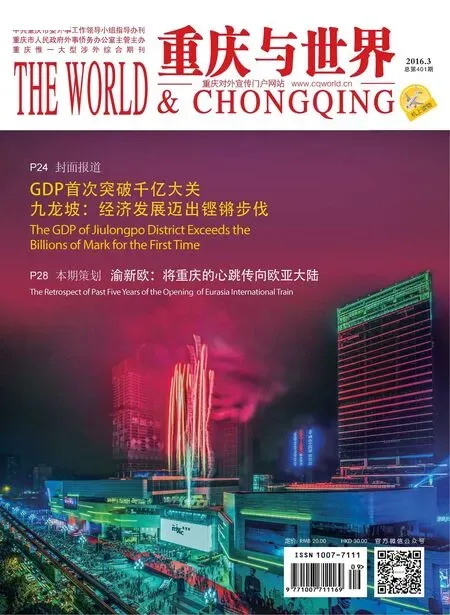来丰都旅游,还有哪些“亮点”不得不看?
来丰都旅游,还有哪些“亮点”不得不看?
丰都是旅游名城,被誉为东方“神曲之乡”。丰都还是一个具有典型的立体地形和立体气候的地方,除了长江沿岸的低海拔地区,还有大量的高山地区。这些高山地区森林丰茂,空气极好,自然景观丰富,夏季清凉舒爽,是城里人避暑纳凉、休闲旅游、养生度假、唤醒乡愁、回归自然最向往的地方。
雪玉山:重庆十佳避暑休闲目的地
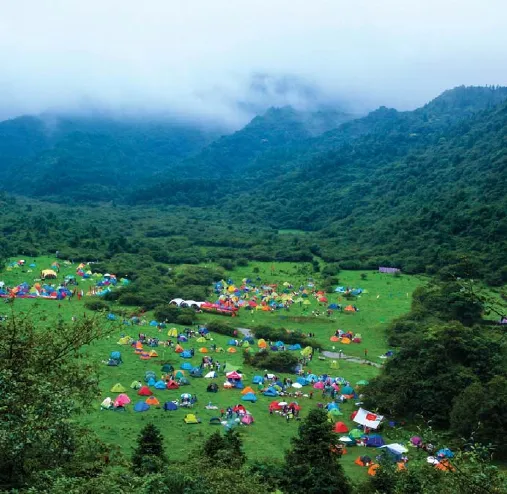
雪玉山地处武陵山系七曜山脉,海拔高度1200~1988米,原始森林面积达13万亩,年均气温12℃~23℃。雪玉山旅游度假区境内有喀斯特地貌特征的峰林、洞穴、峡谷,溪流、地下河、天然草场等景观,海拔1600米左右,夏季平均气温20℃,森林覆盖率达70%,天然负氧离子含量120000个/立方厘米,旅游区内可观云海日出、古庙、草原,可体验骑马、滑草、狩猎,更有民族歌舞、激情篝火、七夕相亲节、湿地露营节等活动让人流连忘返。是休闲、度假、养老的绝佳胜地,被评为重庆市十佳避暑休闲目的地。
南天仙湖:春夏秋冬皆壮美

从丰都县城到仙女湖镇50多公里的黄金旅游线,串着3颗明珠,那便是丰都的3个精品旅游景区,除了丰都名山、雪玉洞外,就是南天湖了。南天湖位于仙女湖镇的峦堡山,地处海拨1700米的山顶之中,水从天上而来,蔚为壮观神奇。
南天湖景区的旅游旺季在夏天。夏日之际,万木葱茏,百花争艳,天空多晴朗,凉风吹不缀,是避暑休闲的胜地。不过到了秋季特别是仲秋季节,又别是一番浓艳的景色。在大片大片由绿变成金黄的落叶松带领下,漫山遍野的彩叶缤纷呈现,秋阳之下艳丽夺目。到了冬季,总有几场大雪铺天而至,大雪覆盖之下的景致也多姿多彩,湖边的滑雪场自然有络绎不绝的红男绿女欢声雀跃,一排排傲雪挺立的柳杉像矗立在路边的巨型屏风,顶上生长着植物的石柱都变成了唯美的盆景,细水滴流的石壁挂上了晶莹剔透的冰瀑,农家的炊烟和打雪仗的孩子成为一片洁白中鲜活的风俗画。
方斗山:修身养性好去处
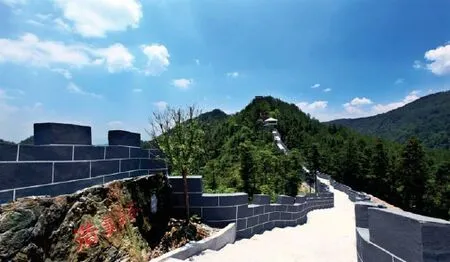
丰都方斗山平均海拔1200米,林地覆盖面积达10万余亩,山中立体气候明显,年平均气温只有12℃~16℃,气候宜人。方斗山休闲旅游度假区,位于丰都县江池镇横梁村,距丰都县城30多公里。其海拔1200米左右,夏季平均气温25℃,森林覆盖率达74%,天然负氧离子含量130000个/立方厘米,是避暑纳凉、休闲度假、修身养性的好去处。方斗山获评农业部“美丽乡村”创建试点村、重庆市农民示范新村、重庆市“最佳避暑休闲乡村”、重庆市现代农业示范工程实施区等殊荣。
● 本栏目图片由丰都旅游局提供
Fengdu County is known throughout the world as a ghost city.
The Fengdu Ming Mountain (or Ming Mountain in ghost city) is a wondrous flower of tourism culture with most mysterious charm as well as the most shinning name card that speaks for Fengdu tourism. Reputed as one of the fi rst batch of key national tourist resorts in 1982 by the State Council, the mountain is also the most inviting tourist attraction in Chongqing, one of the 4A national tourist attractions and one of the most renowned scenic spots of humanities.
Fengdu Ming Mountain, originally known as Pingdu Mountain, boasts a standing history. According to legend, a high-ranked official named Yin Changsheng in Western Han Dynasty and a millionaire in Eastern Han Dynasty named Wang Fangping used to conduct Taoism practice and become immoral beings here. Since then, the place has been regarded as a holy mountain with gods and the immortals and attracted many literati celebrities, and tourists from all parts of the country. It was in North Song Dynasty that the mountain was titled as “A Worldrenowned Ancient Mountain” and rise to fame when Su Shi (a famous Chinese poet of Song Dynasty) composed in his lines“Fengdu ancient Ming Mountain under heaven”.
In the Tang Dynasty, the place was not only believed as a site for people who wish to be immortal through religious practice, but also the residence of the King of the Underworld, where all people in the living world must report themselves after death. So it was changed into a ghost town and the ghost culture since then took root and flourished here. The whole mountain presents to us the peculiar and unique Chinese culture of ghosts and gods through untold temples, towers, bridges and pavilions, inscriptions and sculptures. Meanwhile, a series of tours, pilgrim and temple fair that helps render the untold legends and tale on ghosts and gods also contributes to this culture wonder in the world and the best feature as well as the most mysterious yet attractive part of the place. Out of admiration many men of letters and foreign dignitaries including Bai Juyi, Su Shi (Su Donpo), Lu You, Fan Chengda, Yasuhiro Nakasone, Tomiichi Fuji, Haydon and Kissinger used to go sightseeing here.
The number of temples reached 78 in its prime and all of them are not merely carriers of ghost culture, but also of Taoism, Buddhism, and Confucianism that balance with each other evenly and coexist. For example, the existing Erxian Tower, Liaoyang Palace, and Wuyun Academy are respectively buildings of Taoism, Buddhism and Confucianism. All of them have embodied the inclusiveness and integration of Chinese culture.
Erected on the bank of the Yangtze River, the Ming Mountain is secluded in ancient woods and zigzag flagstone paths. Here you can fi nd more than 30 well-preserved cascading temples with ancient Chinese style including Hengha Shrine, Baoen Palace, Wuchang Palace, Liaoyang Palace, Tianzi Palace, Erxian Tower, and Wuyun Tower; poems and inscriptions by historical celebrities such as Li Bai, Su Donpo, Lu You and Fan Chengda; conjoined calligraphy literally means “only kindness can bring us harmony by modern famous calligrapher Li Banli as well as a large memorial archway on which Qi Gong inscribed A Land of Divine Comedy. The most famous scenic spots here are The Bridge of Helplessness, The Gate to Hell, Yellow Spring Road, Tianzi Palace, and the Eighteen-floored Hell.
The ghost culture here is a container of the essence of Chinese culture whose core is “kindness”—kindness that persuades people to be virtuous and dare to punish the vicious. While standing on the “Bridge of Helplessness”, walking on the“Yellow Spring Road” Sitting at the “Home-viewing Pavilion” at once chewing the tales from the builders on mind, it is easy to see that a person must be kind enough to do good deeds and must not be wicked to do anything bad throughout his/her life, for one good turn deserves another and what goes around comes around. And once you see that and insist to be a kind person, you will be fearless and fully at ease when embracing death.
Some Famous Scenic Spots in Fengdu Ming Mountain
Bridge of Helplessness
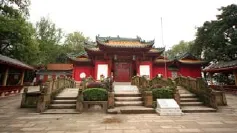
Located at halfway up the mountain and built during the Yongle Period of Ming Dynasty(1403-1424A.D), the Bridge of Helplessness is a testing point that differentiates the good from the bad, links history and reality, nether world and real world and judges death and survival. The left part is called “Bridge of Health” and the right part “Bridge of Wealth”.
As the first pass of the “Three Passes” according to legends, the Bridge of Helplessness bears the greatest prestige. It is said that the spirit of dead people would drink up the fi ve-fl avored tea of forgetfulness made by Meng Po and passed the Bridgeof Helplessness before reincarnation for a new birth. The good ones are allowed to pass easily with the protection of gods while the evil will be thrown into the bloody pool as punishment. The saying is proofed elaborately by the book—A Survey on Fengdu Religious Customs: “…The bridge consists of three layers. The spirit of the good people will pass the upper one safely and half good and half evil ones will have to pass through the middle one. While for those of vicious persons who have no choice but go through the bottom one, they will be obstructed by ghosts who lead them to the fi lthy surging billows below, where iron snakes and dogs always ready to take a furious bite.”
There is a custom for tourists passing through the bridge: married couples should go hand in hand in even steps while the single ones in odd steps. All the passers will be blessed with peacefulness and happiness as long as they walk through the oil-greased bridge without slipping.
The Deathis Gate
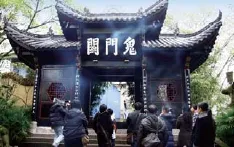
Here comes the Gate to Hell after the Bridge of Helplessness.
The Gate to Hell is the only entrance to the Ghost Kingdom according to legends. Whoever comes to here after death must be subject to check-in procedures to see if he/ she has the passport to the kingdom—a paper travel permit that validates the dead ones who report themselves at the pass of Ghost Kingdom. The permit, about 100cm’s long and 67cm’s wide, is made of yellow printed soft paper, on which are written “Issued by the Yama (King of Hell) to permit the holder to enter the nether world for incarnation into Heaven” and sealed with “City God of the nether world, County Government of Fengdu”. It is to be burnt before encoffi ning so that the spirit may go with it to the nether world unimpeded.
Yellow Spring Road
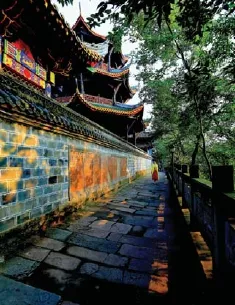
The world of the mortal is but a dream and the dim nether world is also unreal. Walking through the Gate of Hell, you will come to the Yellow Spring Road which is 2 meters’ wide and 50 meters’ long and rather bumpy.
The Yellow Spring refers to the dwelling place of the dead in Chinese culture. Because the water tends to be yellow while one drills deep enough a well and usually people were buried underground after death, the ancient Chinese people naturally relate the deep zone where the yellow spring fl ows to the underworld for the dead, that is, the netherworld. The Yellow Spring is also called the “Nine Springs” which means that the netherworld is as deep as the distance of digging nine springs. And the Yellow Springs Road in Chinese mythology and Taoism classics refers to the road for the dead who will report their arrival to the King of the nether world.
Home-viewing Pavilion
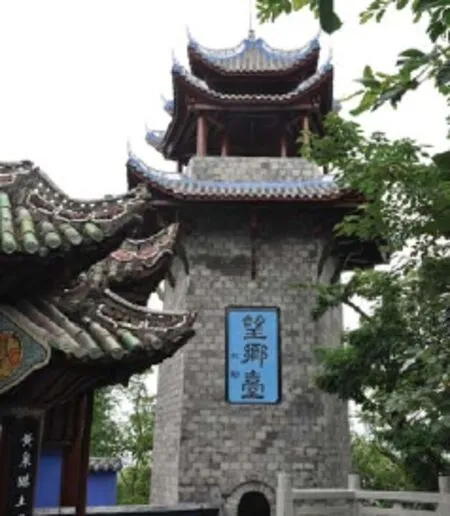
The Home-viewing Pavilion is the next scenic spot after the Yellow Spring Road. According to tales, people will be wailing here while glancing back at their families three days after their death. In spite of violent anger and pushing from the ghost soldier, their desperate solicitude towards their family forces them to climb up the pavilion for the last glance at home. And they will reluctantly enter the nether world before having the last good cry. Therefore the pavilion is also known as “the mountain range of homesickness”and becomes a holy place that allows contact between the living and the dead and a window for spirits to take a distant glance at the real world.
Tianzi Palace

The Tianzi Palace in ancient Chinese mythology is the dwelling of Yama, the supreme ruler of the nether world and, the leading offi ce of Ghost City of Ming Mountain.
Sitting in the west and facing the east, the Tianzi Palace built in the Western Jin Dynasty has a history of more than 1,600 years. The existing one was restored in Kangxi Period of Qing Dynasty (1663A.D.) and boasts a history of more than 300 years. Covering a area of 2,431㎡, the palace is composed of three parts including archway, gate, and hall symmetrically arranged in a central axis. The architecture is the core of the Ghost City as well as the most well-preserved temple with the longest history and largest area in Ming Mountain.
The Eighteen Levels of Hell
In the bungalows on each side of the palace there are the eastern hell and the western hell, also known as the Eighteen Levels of Hell, where all kinds of kings of law enforcement and punishments can be found. The Eighteen Levels of Hell is an assumption by people and it aims to persuade us to do as many good and virtuous deeds as we can in the living world.
The 1stlevel is the Tongue-pulling Hell set for those who sow the seeds of dissension, smite with the tongue, lie and defense their bad deeds with glib tongues in the living world. They will be sent here after death to have their mouth open and tongue pulled out bloodily with a hawksbill by ghosts.
The 9thlevel is the Oil-bathing Hell set for those who do prostitution business, commit robbery and traffi cking of children and women, bully and deceit the weak, slander others and misappropriate other’s property and wife. They will be sent here naked after death and thrown into the oil-bathing boiler for one time or untold times in accordance with the seriousness of the case.
The 13thlevel is the Hell of Bloody Pool used to punish those who are dishonest, leading a crooked life and paying no respect for others and their parents. They will be sent here pledged into the bloody pool and suffering.
The 17thlevel is the Hell of Millstone which punishes those who spoil cereals, thieves, corrupted officials, and those who oppress the people after death. Here they will be grounded into meat sauce and reshaped for one round after another. Besides, carnivore monk and Taoist priest will also take the same sentence.
There are two shinning trump cards of the ghost city culture: one is the Ming Mountain while the other is the Holy Shrine of Jade Emperor. So basically you can experience both the wonderful adventure through “hell” and “heaven”.
Just as the God in the western world, the Jade Emperor is the most powerful god in Chinese ancient mythology. And the Holy Shrine of the Jade Emperor, which locates in the Fivefish Mountain(also known as the Heaven Mountain)right by the side of the Ming Mountain Scenic Area, was exploited on the basis of the concept of “ Ghost City” and “Heaven” with an attempt to demonstrate the classical architectural beauty of“secluded old temples ” and “overhanging eaves with clouds”as well as the traditional cultural value of Buddhism, Taoism, and Confucianism that root in “morality”, “kindness” and “good will”. Taking spiritual beliefs blessed by gods as its carriers, the place has integrated culture with architecture to represent the understanding, inheritance, and dissemination of the 5000-year Chinese traditional culture. It is a signifi cant sort of supplement and refi nement to the ghost culture of Ming Mountain.
The hell in ghost city of Pingdu Mountain and the heaven dwelling of Emperor Jade supplement each other and form a spectacular and distinctive view.
According to the world history of Taoism, the Jade Emperor as the lord of all gods shares the highest status and authority. In the intersection between history and culture, the westerner believes in God while the Chinese believes in the Jade Emperor, who is worshiped by the billions of descendents of the Yan and Huang Emperor.
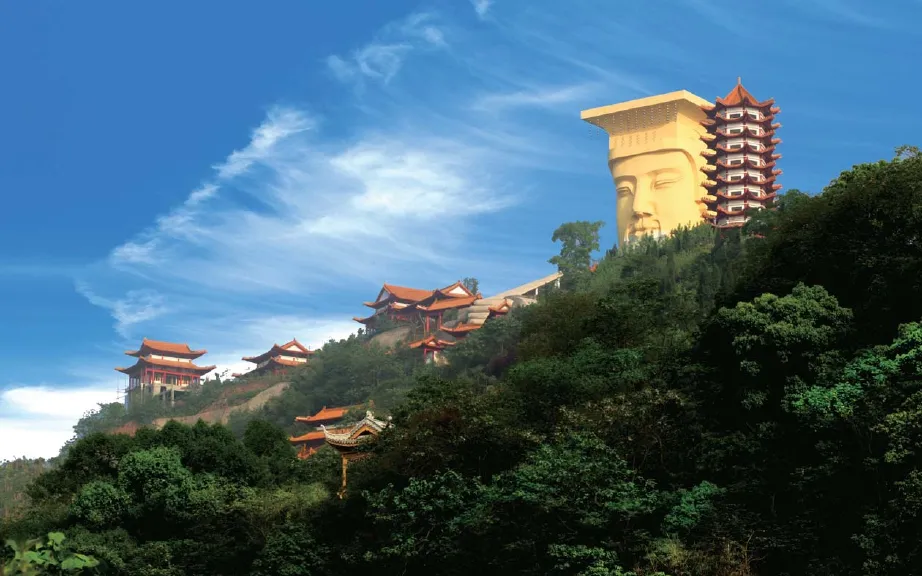
The Five-fish Mountain is the shrine of the Jade God. It forms a spectacular view on earth with the Pingdu Mountain where the King of the nether world is enshrined. There is a saying that goes “take a walk through the ghost city and you will live till ninety-nine.”; “A Trip to ‘heaven’ after ‘hell’, you will fi nd the Jade Emperor there blessing you well”. After a tour around the ghastly “hell”, you should come to the Jade Palace in “heaven”to pray for health for your family and a bright career.
Themed on the ghost culture of the Jade Emperor, architectures in the shrine of the Jade Emperor are arranged according to “Tai-chi”, “Four Images”, “Five Elements” and“Eight Trigrams” and built around the mountain to the traditional culture of beliefs. Water mist in the mountain drifting down to your face gives you a sense of refreshment. When the mountain breeze comes, the mists now gather together to present to you an amazing view of a vast sea of clouds, now scatter to become such ever-changing camoufl age of the immortals as auspicious clouds, waterfall and smoke. This is the peculiarity of the landscape in Five-fish Mountain. Traveling from the hill foot to the top, you will be amazed by the shifting views as you move—falling water mist, lovely streams, rainbow in sunshine that looks like a galaxy in the Southern Gate of Heaven in the Chinese mythology. All these form the beauty of randomness mixed with orderliness. While wandering you are also able to enjoy the charm of the sky, be a guest of the Festival of the Immortal Peach in Chinese mythology, and appreciate the profound ghost culture in a relaxed and merry way till you get the wisdom of Chinese culture and do not want to leave.
Snow Jade Cave: A world-class Cave of Wonder
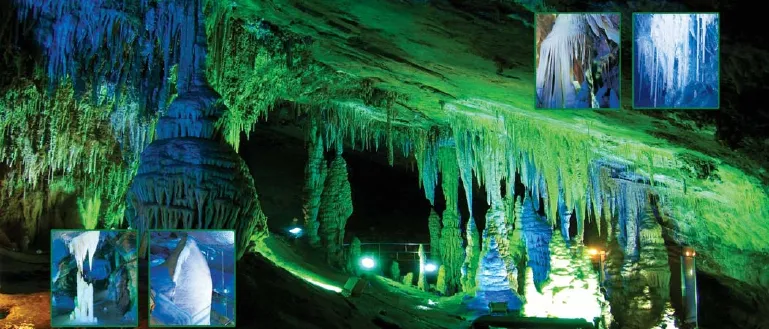
Fengdu is both a place of celebrities and wonders. As the youngest exploited karst cave so far in China, the Snow Jade Cave boasts high ornamental value and scientific value. It is named after the fact that 80% of stalactites in the cave are “as pure and white as snow and jade” according to Professor Zhu Xuewen, head of the Commission of Speleology of China (CSC). It is also accredited by the commission as the “cave science base” and “the observation and research station of CSC and Geology Society of China (GSC).”
1,644 meters’ long, of which 1,161 meters have been explored, the Snowy Jade Cave is spread over three levels and divided into 6 major sightseeing areas including Galaxy of Falling Green, The Infinite on Earth, The Way Up, Northern Scenery, Jaded Mansion and Palace, and lastly the Bright Future. And according to leading experts, the cave has four world-awing wonders: the first is the largest coral flower group; the second is the crystallized “Stone King’s Flag”, which is the longest and thinnest in the world. The third one is the 4-meter-long “Stone Shield” and the forth one is the 2.5-meter “King of Gooseneck”. And there are also more than 10 other wonders and 100 accessible views in the cave. What a place full of treasure and wonderful view!
With the Snow Jade Cave as its core, the Long River Valley Scenic Area was titled by the country as a 4A national tourist attraction in 2006 and evaluated by the Chinese National Geology Magazine as one of the “most beautiful places of China”. While enjoying the beauty of such an amazing wonder gifted by Mother Nature, we shall of course have a heart of gratitude and awe towards her and regard ourselves as her son, embrace her and share common beauty with her consciously.
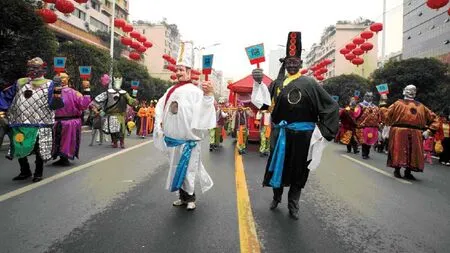
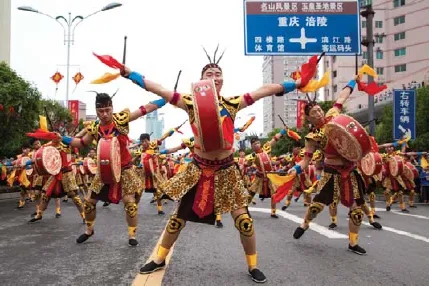
The 2016 China · Fengdu Temple Fair
The 2016 China• Fengdu Temple Fair will be held from April 8th to 16th. This is the second time of the event since it was enlisted as National Intangible Cultural Heritage in 2014.
Fengdu temple fair is a folk custom cultural event that is very popular in Fengdu County of Chongqing. It is held in the old times on the birth date of the lord god, thus becoming a form for daily economic interaction between the locals.
The temple fair in this year consists of such three sessions as Buddhism activity, Literary and artistic activity, and commercial activity. Among of which the religious Buddhist activity including extension Pufo, free captive animals, lighting ceremony, pray to Buddha for 7 days; the literary and artistic activity includes welcome party, street parade, and the characteristics of Chinese intangible cultural heritage show performance, Russia circus.
Eminent Buddhist scholars will be invited to the temple fair to pray Buddhas to recite disaster, organizing Buddhist people for releasing activities, organizing visitors and worshippers for lighting activity, organizing monks to chant sutras.
Meanwhile, all scenic spots will carry out a series of activities: Mingshan mountain scenic area- Mingshan prayer activity, Mingshan fete activity, Cheng Huang fete, Shuangguishan lantern parade; Yu Huang saint scenic area –mountain climbing blessing bell, award-winning treasure hunt; Fangdou Moutain scenic area-"climbing the great wall and gourmet" parent-child activity; South Lake scenic spot-"Beautiful Fengdu • South Lake" Lake cycling race and "Beauty of Fengdu• Lake trip" photographic contest; Snow jade cave scenic spotthe snow Princess singing activity, boating. Commercial activity focuses on "Chongqing (Fengdu) 4th Beef Culture Festival", highlighting the "Fengdu beef" brand, and showing the quality of organic agricultural products in the form of "eating, showing, doing".
Fengdu as a famous tourist city is reputed as the oriental “Land of Divine Comedy”. It is also a place blessed with typical stereoscopic landform and climate. Apart from the low-altitude area along the bank of the Yangtze River, it boasts a large high-altitude region of mountains with luxuriant forests, extremely fresh air and abundant resource of natural landscape. The refreshing and cool breeze in summer makes it the most desirable place for city dwellers who wish to escape from the heat, go on a healthy vacation and re-experience nostalgia and embrace Mother Nature.
Snow Jade Mountain: one of the top 10 summer leisure destinations in Chongqing
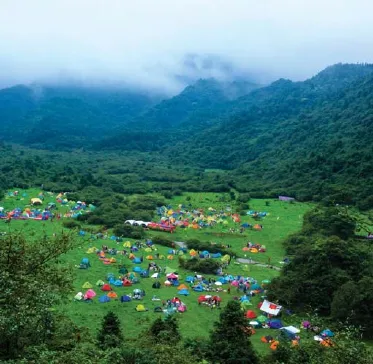
The Snow Jade Mountain is located in the Qiyao Mountain Range of Wulin Mountain System. Due to an altitude between 1200 and 1988 meters and a forest coverage area as large as 130,000 mu (about 8666 hectares), the annual average temperature of it only ranges between 12℃ and 23℃. In the holiday resort you can find peak forests, caves, canyons, brooks, underground stream, and native pasture with features of karst landform. Here the altitude is about 1600 meters and the average temperature in summer is 20℃. The 70% forest coverage rate will offer you an amount of natural negative oxygen ions as much as 120,000 per cubic centimeter. You can enjoy the sunrise on clouds, take a walk in ancient temples and pastures, and experience a series of lingering activities that including horse riding, grass skiing, hunting and even folk dances, bonfi re party, dating festival, and wetland camping. As one of the top 10 summer leisure destination in Chongqing, it is surely a strongly recommended place for leisure life, holidaying and retirement life.
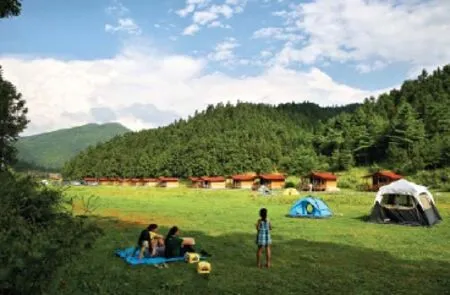
Nantian Lake: an all-season beauty

There are 3 quality tourist scenic spots just like 3 linked pearls along the 50-kilometer golden travel line between Fengdu County and Fairy Lake Town. Besides Fengdu Ming Mountain, Snow Jade Cave, the last one is Nantian Lake. Located on the top of the Luanbao Mountain in Fairy Lake Town, the lake boasts a 1.700-meter altitude and was spectacularly fi lled with water from the heaven.
Summer is the heated tourist season of Nantian Lake Scenic Spot. In summer when hundreds of woods and blooming fl owers turn luxuriant in constant cool breeze under the clear sky, the place becomes the best destination for summer leisure holiday. In autumn and especially mid-autumn, however, it will present to you another sort of bight-colored view. As the vast stretch of larch forest takes the lead in turning golden yellow, the colorful leave all over the mountains and plains will follow and form a landscape of dazzling beauty in the autumn sunshine. The winter here is often visited by several big snows and the snow-clad view is also varied and beautiful. Naturally there will be endless streams of men and women in red and green merrily frolicking in the skiing field just by the side of the lake, rows upon rows of cedars standing proudly in snow resembling giant wind screens on the road side, pillars on which plants grow that looks like very lovely bonsais, waterdripping cliffs hanged with crystal-like ice cascade, smoke from the farmyard and merry-making children playing a snowball fight. All these have composed a genre painting in a vast of white.
Fangdou Mountain: a good resort for body and mind cultivation

With an average altitude of 1200 meters and a forest coverage area of more than 100,000 mu (about 6667 hectares), the mountain has a notable stereoscopic climate. The annual average temperature here only ranges from 12℃ to 16℃, which makes it a balmy place to go. The Fangdou Mountain Leisure Tourism Resort is located in the Hengliang Village, Jiangchi Town, which is 30 kilometers away from the downtown of Fengdu County. As the resort has an altitude of about 1200 meters, the average temperature in summer is just 16℃. And coupled with a forest——the coverage rate is as high as 74%—that offers 130,000 natural negative oxygen per cubic centimeter, it is definitely a good resort where you can stay away from the summer heat, have a leisure holiday and cultivate your body and mind. It has won a lot of honorable awards such as “Beautiful Village” from the Ministry of Agriculture of China,“Chongqing Demonstration New Rural Village”, “Top Summer Leisure Resort of Chongqing”, and “A Demonstration Area of Modern Agriculture Project of Chongqing” and so on.
All pictures provided by FengduTourism Administration
To Travel in Fengdu One Must Firstly Experience the Adventure through “Ghost Culture”
□ Written and Edited by Tang Gang
To Travel in Fengdu One Must Secondly Experience the Beauty of "Paradise"
What’s more to enjoy during the trip to Fengdu?

